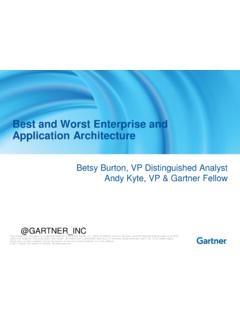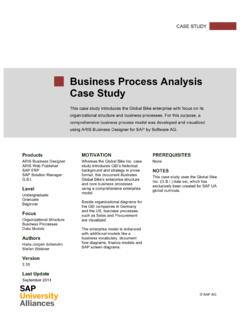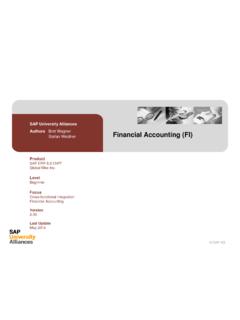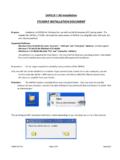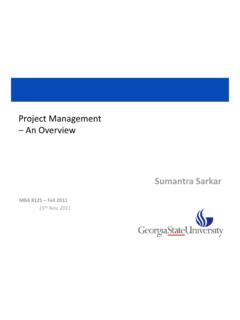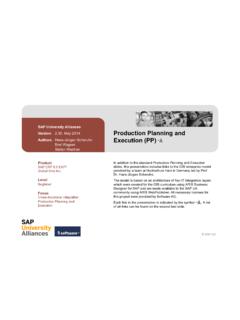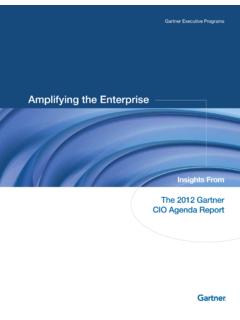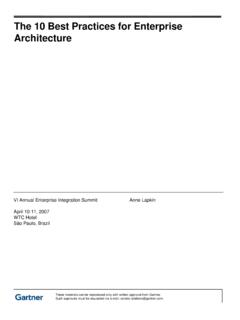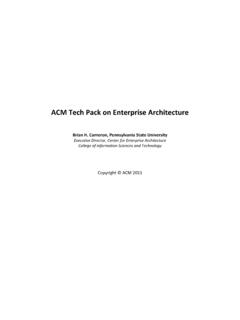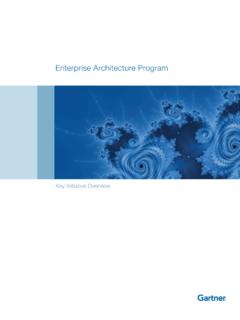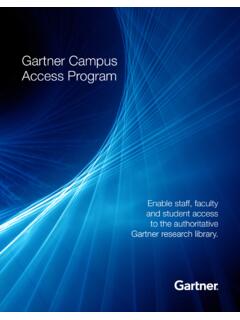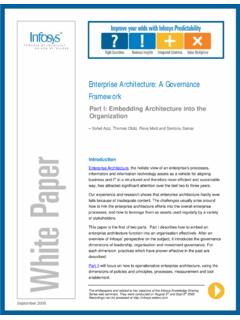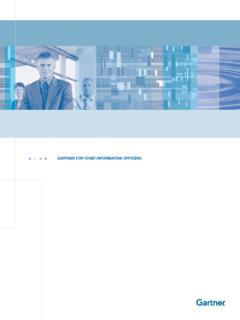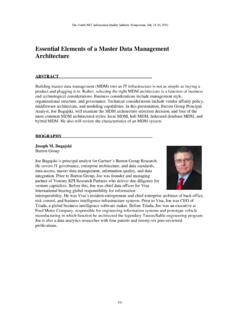Transcription of Guide Enterprise Architecture Efforts Analyst(s): …
1 This research note is restricted to the personal use of research note is restricted to the personal use of the Business Outcome Statement toGuide Enterprise Architecture EffortsPublished: 30 April 2013 Analyst(s): Julie Short, Betsy BurtonLeading Enterprise architects understand the importance of keeping EAefforts focused on delivering business outcomes. The business outcomestatement is an important deliverable to help Guide EA Findings Enterprise Architecture (EA) teams often struggle to know where to begin new or restarted EAefforts, or tend to overfocus on operational aspects. Gaining support and perceived value for EA continues to be a significant challenge for new andongoing EA Efforts . Successful EA Efforts require strong business and IT support to obtain a seat at the architects: Focus on delivering targeted business outcomes that support the business direction and thecritical questions and concerns of senior executives.
2 Clearly understand the business direction and disruptive trends to successfully focus andbalance EA of 2 Statement of Business 4 Statement of Disruptive and IT Executive 5 Target Business 5 This research note is restricted to the personal use of research note is restricted to the personal use of of the Future Business 6 Recommended of FiguresFigure 1. All EA Efforts Must Begin With the Business Outcome 3 AnalysisIn a survey of attendees following gartner 's EA Summit in May 2012, 80% responded that theirprimary focus for EA in 2013 was on aligning business and IT vision and strategies, deliveringstrategic business (and IT) value, or enabling a major business transformation In addition,77% responded that they were either starting, restarting or renewing their EA Given thisfocus on strategic alignment and the large percentage of attendees that were reinventing their EA, itis no surprise that they stated that their top three challenges3 of upper management to support or continue supporting the EA program in orderto achieve the full value from the program and deliver this value to all stakeholders (56%) EA, IT and business strategies to deliver more value to the organization (45%)
3 , scoping and focusing the EA project plan to best meet business goals and create asuccessful EA program (35%)Today, the majority of EA practitioners face the challenge of how to refocus their enterprisearchitecture Efforts to deliver business outcomes. The answer is that Enterprise Architecture effortsmust begin with an understanding of the business outcomes they must deliver, while using businessdirection and strategy as a Guide to determine their effectiveness is moving the organization forwardtoward the future. While we find the majority of organizations aspire to business-outcome-drivenEA, during client inquiries we often speak with organizations that find it difficult to make the leap tofocusing on delivering outcomes and working with business executives, rather than just doing EA inthe traditional, self-centric way. They may spend lots of time focusing on activities such asmodeling or capturing artifacts instead of concentrating their Efforts on identifying and enabling thedelivery of business increase the business focus and scope for EA, a key first step is to define a business outcomestatement for your EA effort (see Note 1).
4 This step is vital, and must be completed to drive theefforts of any EA initiative. A business outcome statement should be a short, three- to five-pagedocument or presentation. A business outcome statement should include: A statement of business direction A statement of disruptive trends Business and IT executive concernsPage 2 of 8 gartner , Inc. | G00250219 This research note is restricted to the personal use of research note is restricted to the personal use of Target business outcomes A high-level (contextual) model of the future business stateWe have discussed the importance of defining an Enterprise context (see "EA Must Include DefiningYour Enterprise Context") and charter (see "An Enterprise Architecture Charter Is a BasicRequirement for All EA Maturity Levels") as part of operating, focusing and scoping EA. Thesedeliverables are important and should be created over time and evolve. However, we sometimesfind that organizations need a higher-level document to focus their Efforts and communicate thisfocus with senior business and IT leaders.
5 With the emphasis on outcome-driven EA, we define thislightweight "just enough" document of the business outcomes as a high-level Guide to inform theorder, prioritization and detail that Enterprise architects might use to define EA deliverables (seeFigure 1 and "Toolkit: First 100 Days of Enterprise Architecture ").Figure 1. All EA Efforts Must Begin With the Business Outcome StatementBusinessOutcomeStatementDefine EA for Your OrganizationSet Up EA TeamCreateCommunicationPlanDefine MetricsCreate First Set of DeliverablesDevelop Enterprise Context Evaluate Your Org. CultureDevelop CharterDevelop GovernanceSource: gartner (April 2013) gartner , Inc. | G00250219 Page 3 of 8 This research note is restricted to the personal use of research note is restricted to the personal use of of Business DirectionThe statement of business direction refers to the strategic and operational aspirations of theorganization (see Note 1).
6 Depending on a number of factors, organizations may focus on bothaspects at any given time. EA practitioners may struggle to understand or get their organizations todefine a business direction. It is important for Enterprise architects to take their cue from theirorganizations and not insist on or wait for a defined strategy to be in place to enable them to deliverbusiness value. If this is the case, then the EA team should try to glean the business direction frompublic statements (such as financial filings and annual reports), management presentations, pressreleases and public records. A best practice is to go to management with what you believe are thebusiness direction and business strategy and let management correct your draft, rather thanpresenting executives with a blank slate. The statement of business direction does not need to bean extensive effort or a comprehensive deliverable. Its purpose is to develop a commonunderstanding between EA practitioners and their business and IT stakeholders as to longer-termdirection, sometimes referred to as strategy.
7 In fact, business direction is a superset of strategy,and must be used to balance current EA effort with the longer-term direction of the example, Enterprise architects may be asked to identify the impact of replatforming a set ofapplications because the underlying database version is no longer supported by the this may not be the strategic work that Enterprise architects want to engage in, they mustperform this analysis with an understanding of its impact on the current-state and future-statearchitecture. The Enterprise architects must be able to provide analysis and planning information tomanagement to support this effort. They will need to identify impacts to the organization, businessprocesses, middleware or underlying technologies. This is an example of a diagnostic , if Enterprise architects have an understanding of the business direction and possibledisruptions, they may look for opportunities to upgrade or consolidate technologies, or tostandardize or optimize processes as part of their recommendation.
8 Enterprise architects shouldalso take this opportunity to make other suggestions (actionable and diagnostic deliverables) aspart of this effort that moves them toward accomplishing the future of Disruptive TrendsDisruptive trends may be technology- or business-based (see "Toolkit: Business Direction andDisruption Analysis Worksheet"). These trends impact the business direction and may alter itpositively or negatively. Like any disruption, Enterprise architects must be capable of addressingthese disruptive trends at any time. The Nexus of Forces (social, mobile, cloud and big data) is anexample of a group of disruptive trends. Other disruptions may include market volatility, regulatorychange and the following examples: A global sports manufacturer might need to understand the disruptive effect that social mediahas on how people review products, or how global climate change affects the sports thatpeople play and the equipment they choose to 4 of 8 gartner , Inc.
9 | G00250219 This research note is restricted to the personal use of research note is restricted to the personal use of A government organization located in the Asia/Pacific region might need to understand thedisruptive impact of a shift in the political landscape, as well as the changes this might have onits services, regulatory requirements or a potential merger with another agency. A financial services organization in Europe would need to understand the disruptive impact ofchanges in the euro and the effects of an aging workforce (see "Eight Actions EA PractitionersCan Take to Help Their Businesses Respond to the Euro Crisis").Business and IT Executive ConcernsIt is vital that Enterprise architects understand the concerns and questions of their key stakeholders both in IT and the business as they relate to the business direction. These concerns andquestions are key to enabling EA practitioners to focus on creating actionable and diagnosticdeliverables that will be considered valuable by the organization.
10 Too often, Enterprise architectsignore such concerns, and carry on with what they think the Enterprise needs or proceedimmediately to functional-requirements gathering. This approach almost guarantees the failure of anEA effort, and diminishes the perception of the EA team among stakeholders who are mostimportant to the EA concerns or questions could do we increase the value and impact of a company we just acquired and reduce theoverlaps in sales, products and operations? can we increase the safety and security of citizens in our region by leveraging partneragencies and emerging technologies while controlling spending? can we do to invest in innovative new ventures that could grow our business in the longterm without eroding our current operations and market position?Depending on the existing relationship between IT and the rest of the business, EA teams mayreceive these concerns indirectly. For example, this information may come through the CIO ratherthan directly from the all stakeholder concerns must be taken seriously, it is important to understand and balancethese concerns with the need to adhere to the business direction.
